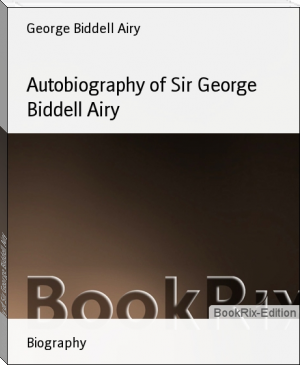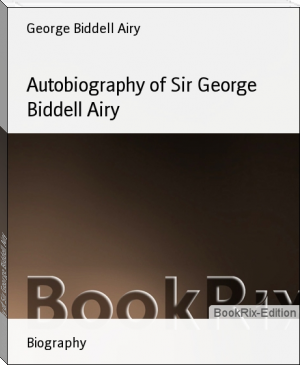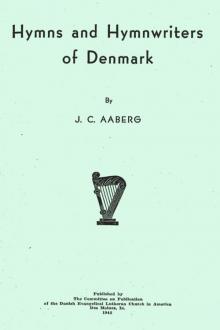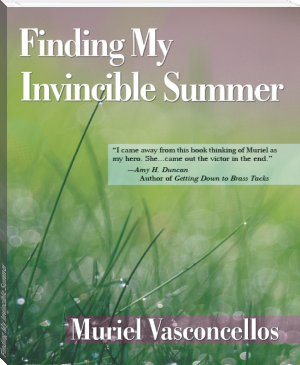Autobiography of Sir George Biddell Airy, George Biddell Airy [dark books to read TXT] 📗

- Author: George Biddell Airy
Book online «Autobiography of Sir George Biddell Airy, George Biddell Airy [dark books to read TXT] 📗». Author George Biddell Airy
Astronomy, to which his name should be attached. There must have been some conversation with me, but the first letter is one from De Morgan in August. In September I had a conversation with Miss Sheepshanks, and sent her my first draft of a scheme, to which she assented. On Sept. 30th I wrote to Whewell (Master of Trinity) who was much trusted by Miss Sheepshanks: he consented to take part, and made some suggestions. There was further correspondence, but the business did not get into shape in this year.--In connection with the Correction of the Compass in Iron Ships: I discussed the observations made in the voyage of the Royal Charter. On Feb. 13th I proposed to the Admiralty a system of mounting the compasses with adjustable magnets, and it was ordered to be tried in the Trident and Transit.--In February I reported to the Admiralty that the Deal Time-Ball had been successful, and I proposed time-balls at Portsmouth, Plymouth, and Sheerness. There was much correspondence in various directions about Portsmouth and Devonport, and in March I went to Devonport and specially examined Mount Wise and the Devonport Column.--I had correspondence with Sir Howard Douglas about the sea breaking over the unfinished Dover Pier. I have an idea that this followed evidence given by me to a Harbour Commission, in which I expressed as a certainty that the sea will not be made to break by a vertical wall."
Of private history: "I returned from Playford on Jan. 18th.--From June 16th to August 5th I was, with my son Wilfrid, on an expedition to South Italy and Sicily: on our return from Sicily, we remained for three days ill at Marseilles from a touch of malaria.--On Dec. 22nd I went to Playford.--In acknowledgment of the pleasure which I had derived from excursions in the Cumberland Passes, I made a foot-bridge over a troublesome stream on the Pass of the Sty Head."
1857
"In the Report to the Visitors, when on the subject of the Altazimuth, the following paragraph occurs: 'I alluded in a preceding section to the cutting away of a very small portion of one of the rays of the three-armed pier which carries the Altazimuth. The quality of the brickwork is the best that I have ever seen, and not a single brick was disturbed beyond those actually removed. Yet the effect was to give the Altazimuth an inclination of about 23". This inclination evidently depends on the elasticity of the brickwork.'--With reference to the new S.E. Equatoreal the Report states that 'The support of the north or upper end of the polar axis has been received, and is planted within the walls of the building in a position convenient for raising it to its ultimate destination. It is one piece of cast-iron, and weighs nearly 5 tons.'--Small changes as previously mentioned had been noticed with regard to the Zero of Azimuth of the Transit Circle, and the Report states that 'In regard to the Azimuth of the Transit Circle, and the Azimuth of its Collimator, Mr Main has brought together the results of several years, and the following law appears to hold. There is a well-marked annual periodical change in the position of the Transit Circle, the southerly movement of the eastern pivot having its minimum value in September, and its maximum in March, the extreme range being about 14 seconds; and there is a similar change, but of smaller amount, in the position of the Collimator. I cannot conjecture any cause for these changes, except in the motion of the ground. There is also a well-marked connection between the state of level of the axis and the temperature. The eastern pivot always rises when the temperature rises, the extreme range being about 6 seconds. I cannot offer any explanation of this.'--Under the head of Extraneous Works the Report states that 'The British Government had for some years past contributed by pecuniary grants to the preparation of Prof. Hansen's Lunar Tables. In the last winter they undertook the entire expense of printing a large impression of the Tables. The reading of the proof-sheets (a very considerable labour) has been effected entirely at the Observatory. I may take this opportunity of stating that the use of these Tables has enabled me, as I think, incontestably to fix the capture of Larissa to the date B.C. 557, May 19. This identification promises to prove valuable, not merely for its chronological utility, but also for its accurate determination of an astronomical epoch, the point eclipsed being exactly known, and the shadow having been very small.'--In April I gave a lecture to the Royal Astronomical Society on the methods available through the next 25 years for the determination of the Sun's parallax.--Dr Livingstone's observations for African longitudes were computed at the Observatory.--The Admiralty enquire of me about the feasibility of adopting Piazzi Smyth's construction for steadying telescopes on board ship: I gave a Report, of mixed character, on the whole discouraging.--I had correspondence with G.P. Bond and others about photographing the Stars and Moon.--On Feb. 17th Piazzi Smyth's books, &c. relating to the Teneriffe Experiment were sent to me: I recommended that an abridged Report should be sent to the Royal Society.--Respecting the Sheepshanks Fund: there was correspondence with Miss Sheepshanks and Whewell, but nothing got into shape this year: Miss Sheepshanks transferred to me _L10,000_ lying at Overend and Gurney's.--In November experiments were made for the longitude of Edinburgh, which failed totally from the bad state of the telegraph wire between Deptford and the Admiralty.--In June the first suggestion was made to me by Capt. Washington for time-signals on the Lizard Point: which in no long time I changed for the Start Point.--The Admiralty call for estimates for a time-ball at Portsmouth: on receiving them they decline further proceeding.--I was engaged in speculations and correspondence about the Atlantic Submarine Cable.--In the Royal Astronomical Society, I presented Memoirs and gave lectures on the three great chronological eclipses (Agathocles, Thales, Larissa)."--On Dec. 5th Airy wrote to the Vice-Chancellor of the University of Cambridge, objecting to the proposed changes regarding the Smith's Prizes--a subject in which he took much interest, and to which he ascribed great importance.--On Apr. 27th I was in correspondence with G. Herbert of the Trinity House, about floating beacons.--In July I reported to the Treasury on the Swedish Calculating Engine (I think on the occasion of Mr Farr, of the Registrar-General's Office, applying for one).--In November I had correspondence about the launch of the Great Eastern, and the main drainage of London."
Of private history: "On Jan. 14th I returned from Playford.--From June 27th to Aug. 5th I was travelling in Scotland with my wife and two eldest sons, chiefly in the West Highlands. On our return we visited Mrs Smith (my wife's mother) at Brampton.--On Dec. 26th I went to Playford."
1858
"In the Minutes of the Visitors it is noted that the new Queen's Warrant was received. The principal change was the exclusion of the Astronomer Royal and the other Observatory Officers from the Board.--In the Report to the Visitors it is stated that 'The Papers of the Board of Longitude are now finally stitched into books. They will probably form one of the most curious collections of the results of scientific enterprise, both normal and abnormal, which exists.'--It appears that the galvanic communications, external to the Observatory, had been in a bad state, the four wires to London Bridge having probably been injured by a thunderstorm in the last autumn, and the Report states that 'The state of the wires has not enabled us to drop the Ball at Deal. The feeble current which arrives there has been used for some months merely as giving a signal, by which an attendant is guided in dropping the Ball by hand.'--Regarding the new Equatoreal the Report states that 'For the new South-East Equatoreal, the object-glass was furnished by Messrs Merz and Son in the summer of last year, and I made various trials of it in a temporary tube carried by the temporary mounting which I had provided, and finally I was well satisfied with it. I cannot yet say that I have certainly divided the small star of gamma Andromedae; but, for such a test, a combination of favourable circumstances is required. From what I have seen, I have no doubt of its proving a first-rate object-glass.'--On March 15th was an annular eclipse of the Sun, for the observation of which I sent parties fully equipped to Bedford, Wellingborough, and Market Harborough. The observations failed totally in consequence of the bad weather: I myself went to Harrowden near Wellingborough.--Respecting the Altazimuth, the Report states that with due caution as to the zero of azimuth 'the results of observation are extremely good, very nearly equal to those of the meridional instrument; perhaps I might say that three observations with the Altazimuth are equivalent to two with the Transit Circle.'--Respecting Meteorological Observations the Report states that 'The observations of the maximum and minimum thermometers in the Thames, interrupted at the date of the last Report, have been resumed, and are most regularly maintained. Regarding the Thames as the grand climatic agent on London and its neighbourhood, I should much regret the suppression of these observations.'--After much trouble the longitude of Edinburgh had been determined: 'the retard of the current is 0.04s very nearly, and the difference of longitudes 12m 43.05s, subject to personal equations.'--The Report concludes thus: 'With regard to the direction of our labours, I trust that I shall always be supported by the Visitors in my desire to maintain the fundamental and meridional system of the Observatory absolutely intact. This, however, does not impede the extension of our system in any way whatever, provided that such means are arranged for carrying out the extension as will render unnecessary the withdrawal of strength from what are now the engrossing objects of the Observatory.'--I had much correspondence on Comets, of which Donati's great Comet was one: the tail of this Comet passed over Arcturus on October 5th.--Respecting the Sheepshanks Fund: In September I met Whewell at Leeds, and we settled orally the final plan of the scheme. On Oct. 27th I saw Messrs Sharp, Miss Sheepshanks's solicitors, and drew up a Draft of the Deed of Gift. There was much correspondence, and on Nov. 20th I wrote to the Vice-Chancellor of Cambridge University. A counter-scheme was proposed by Dr Philpott, Master of St Catharine's College. By arrangement I attended the Council of the University on Dec. 3rd, and explained my views, to which the Council assented. On Dec. 9th the Senate accepted the gift of Miss Sheepshanks.--I had much correspondence throughout this year, with the Treasury, Herschel, Sabine, and the Royal Society, about the continuation of the Magnetic Establishments. The Reductions of the Magnetic Observations 1848-1857 were commenced in February of this year, under the direction of Mr Lucas, a computer who had been engaged on the Lunar Reductions.--In this year I came to a final agreement with the South Eastern Railway Company about defining the terms of our connection with them for the passage of Time Signals. I was authorized by the Admiralty to sign the 'protocol' or Memorandum of Agreement, and it was signed by the South Eastern Railway Directors.--On Aug. 28th I made my first proposal to Sir John Packington (First Lord of the Admiralty) for hourly time signals on the Start Point, and in September I went to the Start to examine localities, &c. On Dec. 23rd the Admiralty declined
Of private history: "I returned from Playford on Jan. 18th.--From June 16th to August 5th I was, with my son Wilfrid, on an expedition to South Italy and Sicily: on our return from Sicily, we remained for three days ill at Marseilles from a touch of malaria.--On Dec. 22nd I went to Playford.--In acknowledgment of the pleasure which I had derived from excursions in the Cumberland Passes, I made a foot-bridge over a troublesome stream on the Pass of the Sty Head."
1857
"In the Report to the Visitors, when on the subject of the Altazimuth, the following paragraph occurs: 'I alluded in a preceding section to the cutting away of a very small portion of one of the rays of the three-armed pier which carries the Altazimuth. The quality of the brickwork is the best that I have ever seen, and not a single brick was disturbed beyond those actually removed. Yet the effect was to give the Altazimuth an inclination of about 23". This inclination evidently depends on the elasticity of the brickwork.'--With reference to the new S.E. Equatoreal the Report states that 'The support of the north or upper end of the polar axis has been received, and is planted within the walls of the building in a position convenient for raising it to its ultimate destination. It is one piece of cast-iron, and weighs nearly 5 tons.'--Small changes as previously mentioned had been noticed with regard to the Zero of Azimuth of the Transit Circle, and the Report states that 'In regard to the Azimuth of the Transit Circle, and the Azimuth of its Collimator, Mr Main has brought together the results of several years, and the following law appears to hold. There is a well-marked annual periodical change in the position of the Transit Circle, the southerly movement of the eastern pivot having its minimum value in September, and its maximum in March, the extreme range being about 14 seconds; and there is a similar change, but of smaller amount, in the position of the Collimator. I cannot conjecture any cause for these changes, except in the motion of the ground. There is also a well-marked connection between the state of level of the axis and the temperature. The eastern pivot always rises when the temperature rises, the extreme range being about 6 seconds. I cannot offer any explanation of this.'--Under the head of Extraneous Works the Report states that 'The British Government had for some years past contributed by pecuniary grants to the preparation of Prof. Hansen's Lunar Tables. In the last winter they undertook the entire expense of printing a large impression of the Tables. The reading of the proof-sheets (a very considerable labour) has been effected entirely at the Observatory. I may take this opportunity of stating that the use of these Tables has enabled me, as I think, incontestably to fix the capture of Larissa to the date B.C. 557, May 19. This identification promises to prove valuable, not merely for its chronological utility, but also for its accurate determination of an astronomical epoch, the point eclipsed being exactly known, and the shadow having been very small.'--In April I gave a lecture to the Royal Astronomical Society on the methods available through the next 25 years for the determination of the Sun's parallax.--Dr Livingstone's observations for African longitudes were computed at the Observatory.--The Admiralty enquire of me about the feasibility of adopting Piazzi Smyth's construction for steadying telescopes on board ship: I gave a Report, of mixed character, on the whole discouraging.--I had correspondence with G.P. Bond and others about photographing the Stars and Moon.--On Feb. 17th Piazzi Smyth's books, &c. relating to the Teneriffe Experiment were sent to me: I recommended that an abridged Report should be sent to the Royal Society.--Respecting the Sheepshanks Fund: there was correspondence with Miss Sheepshanks and Whewell, but nothing got into shape this year: Miss Sheepshanks transferred to me _L10,000_ lying at Overend and Gurney's.--In November experiments were made for the longitude of Edinburgh, which failed totally from the bad state of the telegraph wire between Deptford and the Admiralty.--In June the first suggestion was made to me by Capt. Washington for time-signals on the Lizard Point: which in no long time I changed for the Start Point.--The Admiralty call for estimates for a time-ball at Portsmouth: on receiving them they decline further proceeding.--I was engaged in speculations and correspondence about the Atlantic Submarine Cable.--In the Royal Astronomical Society, I presented Memoirs and gave lectures on the three great chronological eclipses (Agathocles, Thales, Larissa)."--On Dec. 5th Airy wrote to the Vice-Chancellor of the University of Cambridge, objecting to the proposed changes regarding the Smith's Prizes--a subject in which he took much interest, and to which he ascribed great importance.--On Apr. 27th I was in correspondence with G. Herbert of the Trinity House, about floating beacons.--In July I reported to the Treasury on the Swedish Calculating Engine (I think on the occasion of Mr Farr, of the Registrar-General's Office, applying for one).--In November I had correspondence about the launch of the Great Eastern, and the main drainage of London."
Of private history: "On Jan. 14th I returned from Playford.--From June 27th to Aug. 5th I was travelling in Scotland with my wife and two eldest sons, chiefly in the West Highlands. On our return we visited Mrs Smith (my wife's mother) at Brampton.--On Dec. 26th I went to Playford."
1858
"In the Minutes of the Visitors it is noted that the new Queen's Warrant was received. The principal change was the exclusion of the Astronomer Royal and the other Observatory Officers from the Board.--In the Report to the Visitors it is stated that 'The Papers of the Board of Longitude are now finally stitched into books. They will probably form one of the most curious collections of the results of scientific enterprise, both normal and abnormal, which exists.'--It appears that the galvanic communications, external to the Observatory, had been in a bad state, the four wires to London Bridge having probably been injured by a thunderstorm in the last autumn, and the Report states that 'The state of the wires has not enabled us to drop the Ball at Deal. The feeble current which arrives there has been used for some months merely as giving a signal, by which an attendant is guided in dropping the Ball by hand.'--Regarding the new Equatoreal the Report states that 'For the new South-East Equatoreal, the object-glass was furnished by Messrs Merz and Son in the summer of last year, and I made various trials of it in a temporary tube carried by the temporary mounting which I had provided, and finally I was well satisfied with it. I cannot yet say that I have certainly divided the small star of gamma Andromedae; but, for such a test, a combination of favourable circumstances is required. From what I have seen, I have no doubt of its proving a first-rate object-glass.'--On March 15th was an annular eclipse of the Sun, for the observation of which I sent parties fully equipped to Bedford, Wellingborough, and Market Harborough. The observations failed totally in consequence of the bad weather: I myself went to Harrowden near Wellingborough.--Respecting the Altazimuth, the Report states that with due caution as to the zero of azimuth 'the results of observation are extremely good, very nearly equal to those of the meridional instrument; perhaps I might say that three observations with the Altazimuth are equivalent to two with the Transit Circle.'--Respecting Meteorological Observations the Report states that 'The observations of the maximum and minimum thermometers in the Thames, interrupted at the date of the last Report, have been resumed, and are most regularly maintained. Regarding the Thames as the grand climatic agent on London and its neighbourhood, I should much regret the suppression of these observations.'--After much trouble the longitude of Edinburgh had been determined: 'the retard of the current is 0.04s very nearly, and the difference of longitudes 12m 43.05s, subject to personal equations.'--The Report concludes thus: 'With regard to the direction of our labours, I trust that I shall always be supported by the Visitors in my desire to maintain the fundamental and meridional system of the Observatory absolutely intact. This, however, does not impede the extension of our system in any way whatever, provided that such means are arranged for carrying out the extension as will render unnecessary the withdrawal of strength from what are now the engrossing objects of the Observatory.'--I had much correspondence on Comets, of which Donati's great Comet was one: the tail of this Comet passed over Arcturus on October 5th.--Respecting the Sheepshanks Fund: In September I met Whewell at Leeds, and we settled orally the final plan of the scheme. On Oct. 27th I saw Messrs Sharp, Miss Sheepshanks's solicitors, and drew up a Draft of the Deed of Gift. There was much correspondence, and on Nov. 20th I wrote to the Vice-Chancellor of Cambridge University. A counter-scheme was proposed by Dr Philpott, Master of St Catharine's College. By arrangement I attended the Council of the University on Dec. 3rd, and explained my views, to which the Council assented. On Dec. 9th the Senate accepted the gift of Miss Sheepshanks.--I had much correspondence throughout this year, with the Treasury, Herschel, Sabine, and the Royal Society, about the continuation of the Magnetic Establishments. The Reductions of the Magnetic Observations 1848-1857 were commenced in February of this year, under the direction of Mr Lucas, a computer who had been engaged on the Lunar Reductions.--In this year I came to a final agreement with the South Eastern Railway Company about defining the terms of our connection with them for the passage of Time Signals. I was authorized by the Admiralty to sign the 'protocol' or Memorandum of Agreement, and it was signed by the South Eastern Railway Directors.--On Aug. 28th I made my first proposal to Sir John Packington (First Lord of the Admiralty) for hourly time signals on the Start Point, and in September I went to the Start to examine localities, &c. On Dec. 23rd the Admiralty declined
Free e-book «Autobiography of Sir George Biddell Airy, George Biddell Airy [dark books to read TXT] 📗» - read online now
Similar e-books:





Comments (0)